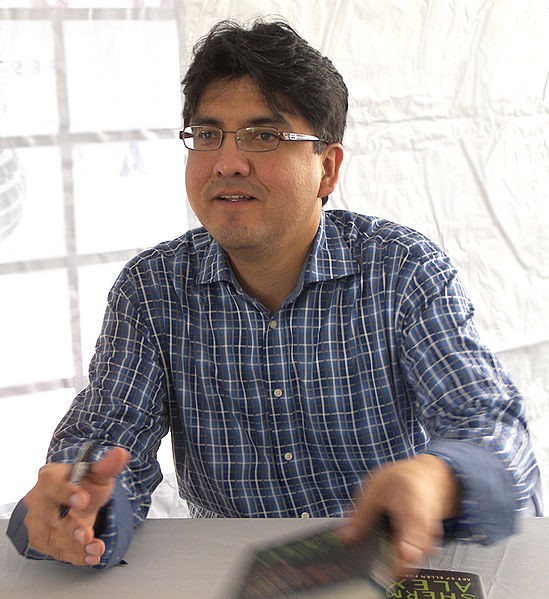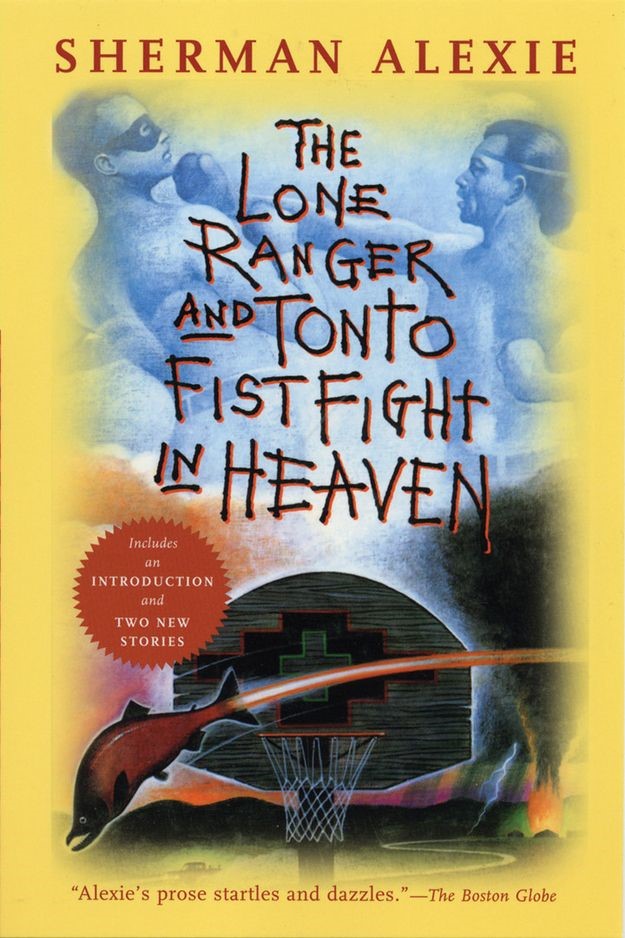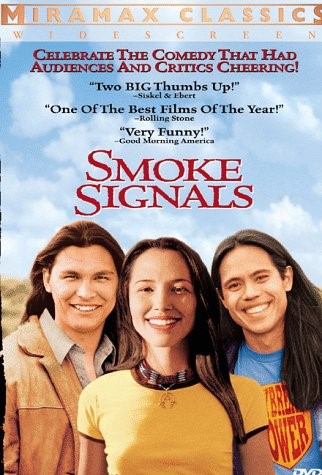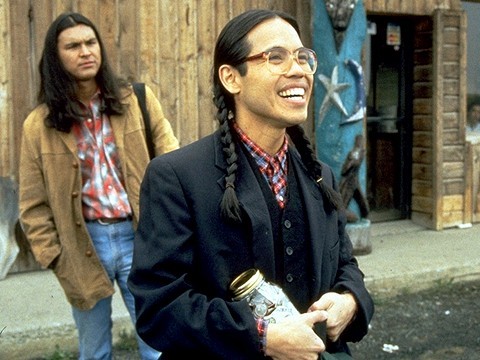
Sherman Alexie is a celebrated author, considered to be at the forefront of the Native American literary renaissance. A movement starting in the 1960’s, in which Indigenous Americans sought to reclaim, and record their oral traditions and history. Utilizing western literary formats these writers challenged the established historical narrative, and explored their new cultural identity. By combining personal history and fiction they created compelling autobiographical accounts.
It is for those reasons that Alexie’s books are so powerful. Through his language and humor Alexie translates the trauma of Reservation life in manner that is accessible to natives, and non-natives. His novel The Lone Ranger and Tonto Fistfight in Heaven is a collection of these experiences. In his introduction to the book Alexie acknowledges that it is “..thinly disguised memoir…”. Due to these fictional narratives being rooted in reality, Alexie has come under fire for his frank portrayals of alcoholism and domestic abuse. For him it was an everyday occurrence, one that natives and non-natives do not wish to acknowledge.
Another issue addressed in his introduction is the problem of magical realism; a label commonly applied indigenous fiction. For Alexie this categorization cheapens the message his literature is attempting to convey. He subverts this attempt at categorization, by declaring his works to be “reservation realism” instead. Rather than defining it, Alexie challenges the reader to discover the meaning for themselves. This ambiguity serving two purposes: first, in placing unreal events next to grim ones, they make the latter more believable. Second, that it reinforces the questioning of established historical events. Showing that just as reality is subjective, so is its written account.

Following the success of The Business of Fancyingdancing, Sherman Alexie was swarmed with publishing offers. The novel had been given a front page review in the New York Times, and in the rush that followed Alexie published a second collection of short stories entitled The Lone Ranger and Tonto Fistfight in Heaven. Two of the re-occurring characters, Victor Joseph and Thomas Builds-the-Fire are self-described aspects of Alexie. Through them he lays out the triumphs and tragedies he experienced growing up on the Spokane Indian reservation. These stories are not just an exploration in personal history. “THE TRIAL OF THOMAS BUILDS-THE-FIRE” dives into the events that shaped the Spokane people. Despite the chapter’s title, it is not Thomas on trial, rather the government that oversaw numerous atrocities: The Spokane horse massacre, Battle of Pine Creek, the betrayal and execution of Qualchan. The last example being particularly egregious, as the city of Spokane has built a golf course named after the Yakama chieftain, in the very valley he was murdered. Embedded below is a Google earth map of the valley. Note the name of the creek running through the course.
The Creek at Qualchan Golf Course
The following short story “DISTANCES” continues this theme, in which Alexie explores an alternate time line in which the Ghost Dance succeeded. This ritual preformed in 1890 at the Standing Rock Reservation, was intended to wash away their colonial oppressors, and punish natives who did not participate.
Standing Rock reservation, South Dakota
Within this grim future, natives are divided into three groups: the Urbans, the Skins, and the Others. The Indians who lived in the cities, but made their way back to the Reservations are the Urbans. They are an accursed and sickly lot. Their offspring are often even worse. Due to these monstrous births they are forbidden to marry the Skins, Indians who were living on the Reservations when the Ghost Dance took effect. Finally there are the Others, Indians returned from a millennium ago. Terrible deathless creatures, recognizably human in form only.
The Lone Ranger and Tonto Fistfight in Heaven, and other works of Sherman Alexie are available in a variety of formats, either through interlibrary loan or at the Peabody Institute of Danvers.
Smoke Signals

Film adaptations can be unsatisfying affairs. The conflict between screenwriter, director, and producer creates a product that does not capture the feel of the source material. Additionally, in making films that appeal to the widest possible audience, studios will risk diluting the essence that made the original product so successful. Scripts will go through multiple rewrites, until nothing of the initial draft remains. This is not the case with Sherman Alexie’s 1993 novel, The Lone Ranger and Tonto Fistfight in Heaven, and its subsequent film adaptation Smoke Signals in 1995. Perhaps this is due to Alexie’s full control over the screenplay, or that the movie was written and directed by Native Americans. In a 2009 interview Alexie addresses several of these issues, acknowledging that Smoke Signals was a unique experience that spoiled him as a writer. That his subsequent experiences as a screenwriter have shown him how fragile that position can be.
Smoke Signals was based on the short story “WHAT IT MEANS TO SAY PHOENIX ARIZONA”, in which Thomas Builds-the-Fire accompanies Victor to pick up his father’s ashes. This in turn was inspired by a trip where Alexie accompanied a friend picking up his father’s ashes. Through incorporating elements from the other stories in The Lone Ranger and Tonto Fistfight in Heaven, Alexie is able to turn a twenty-five-page narrative into a full-fledged script, a feat that took him only two weeks. A careful reader will notice elements of “EVERY LITTLE HURRICANE”, “DISTANCES” and many others. Adam Beach and Evan Adams lend their considerable talents as Victor Joseph, and Thomas Builds-the-Fire respectfully.

When Smoke Signals started to go into production, Alexie wanted to use the Spokane Reservation as the shooting location, a request that was denied by the tribal Council. Certain scenes were filmed in the city of Spokane, such as the bridge in the Spokane Falls region.
North Howard Street Bridge, Spokane Washington
The bridge is located to the southeastern side of Canada Island. Through the earth view in Google maps the distinctive white lattice structure can be seen.
As the Spokane Reservation was unavailable, the Coeur d’Alene Reservation was used as the primary shoot location. Located at the western edge of Idaho, is only one hundred miles or so from the Spokane Reservation, and the birthplace of Alexie’s father.
Cour d’Alene Reservation, Idaho
The scenes in Phoenix Arizona were shot in the Soap Lake region of Washington State.
Soap Lake, Washington
Smoke Signals contained some unique effects that harkened back to the original source material. Throughout the film Victor is seen hopping back and forth through time, from the present to his younger self. The character steps through a doorway, and into a flashback. It is done so seamlessly the initial jump is quite jarring. This mimics the feel of the book, which can feel disjointed at times. Another departure is the cinematic Victor coming across considerably brusquer than his literary counterpart.
Smoke Signals is available through interlibrary loan, Remembering Smoke Signals: interviews with Chris Eyre and Sherman Alexie is available online to Danvers residents. Non-residents can access this e-book through the many public computers available at the Peabody Institute of Danvers, or through our public wifi.
Google Maps
It is one thing to read a book, or see a movie, but to grasp the size and scope of a narrative other methods need to be employed. As Alexie’s works are a veiled biography, a geo-history can be mapped out. Using Google maps I have marked places of interest within The Lone Ranger and Tonto Fistfight in Heaven, and the film adaptation Smoke Signals. Some of these locations were easy to find, others required more digging. For example, the bridge used in Smoke Signals was not immediately apparent. I had to switch to the earth view in order to pinpoint it. For each of the locations I have added information pertinent to the book, and movie. The sections are color coded as follows.
The Yellow Sections are shooting locations for Smoke Signals.
The Blue Sections are for the Spokane Reservation, and city of Spokane.
The Red Sections are the locations for historical battles from “THE TRAIL OF THOMAS BUILDS-THE-FIRE”, and “Desolation”.
The Purple sections are for miscellaneous locations.
Google Map
Links
The official website of Sherman Alexie
Spokane Indian Reservation website
Standing Rock Sioux Reservation website
The Coeur d’Alene tribal website


